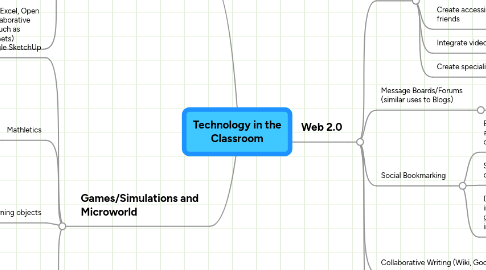
1. "Content Free" Software
1.1. Geogebra
1.1.1. Modeling curve sketching and calculus: students can learn with examples
1.1.2. Dynamic data manipulation with instant feedback: students can discover trends, patterns and test hypotheses
1.2. Mindmapping Software (eg FreeMind or collaborative online platforms such as: MindMeister)
1.2.1. Real time editing and collaboration
1.3. Spreadsheets (eg Excel, Open Office Calc or collaborative online platforms such as Google Spreadsheets)
1.3.1. Presentation of collected data
1.3.2. Analyse and manipulate data for presentation
2. Games/Simulations and Microworld
2.1. Google SketchUp
2.1.1. Design structures and buildings in science
2.1.2. Draw and model 3D objects for maths eg Stage 6 calculus
2.2. Mathletics
2.2.1. Fuel camaraderie and competition while building speed and accuracy
2.2.2. Access to international student math community
2.2.3. Real world peer benchmarking
2.3. Le@rning Federation learning objects
2.3.1. Interactive simulations to gather data and make observations
2.3.2. Scaffolding resources to aid student learning
2.4. GoogleMaps and GoogleEarth
2.4.1. Real time map reading
2.4.2. Interactive coordinates and positioning: real world simulations for exploring distance, areas, weather patterns etc
2.4.3. Time zones: exploration of implications of time zone differences with access to local images
2.4.4. Access to images of local and global locations and sites adds authenticity and context to content
3. Web 2.0
3.1. Blogs
3.1.1. Writing and reflection tool for students to share share their work and thoughts
3.1.2. Use comments, forum, or customized forms to collect feedback, survey data, input and ideas
3.1.3. Share content, links, video, sound and audio assets
3.1.4. Respond to blog posts and discuss topics through comments
3.1.5. Create accessible information for other students, staff, parents and friends
3.1.6. Integrate videos, podcasts, slideshows and other multi-media
3.1.7. Create specialised blogs for organised clubs, student groups, events, sports teams
3.2. Message Boards/Forums (similar uses to Blogs)
3.2.1. Encourage asking of questions and sharing of opinions
3.3. Social Bookmarking
3.3.1. Build a library of internet resources accessible on any web-ready computer or mobile device
3.3.2. Share viable websites and online resources
3.3.3. Discover and connect with individuals and community groups that have similar interests
3.4. Collaborative Writing (Wiki, Google Docs)
3.4.1. Real time editing and collaboration
3.4.2. Accessibility online and cross platform
3.5. Really Simple Syndication (RSS)
3.5.1. Filter content and articles that have relevancy and match interests
3.5.2. Positive transformation of learning and preparation for tertiary and higher order education
